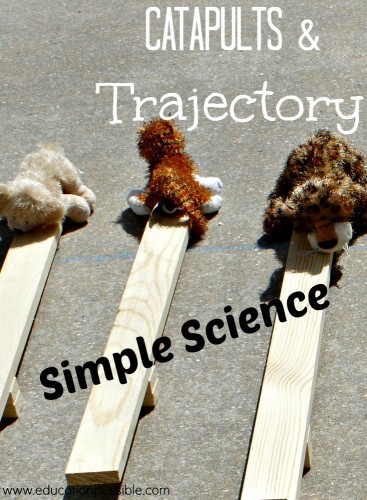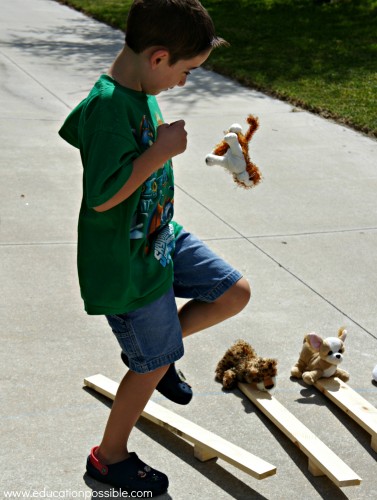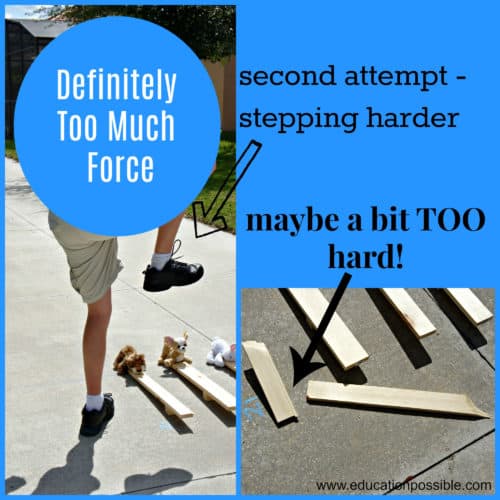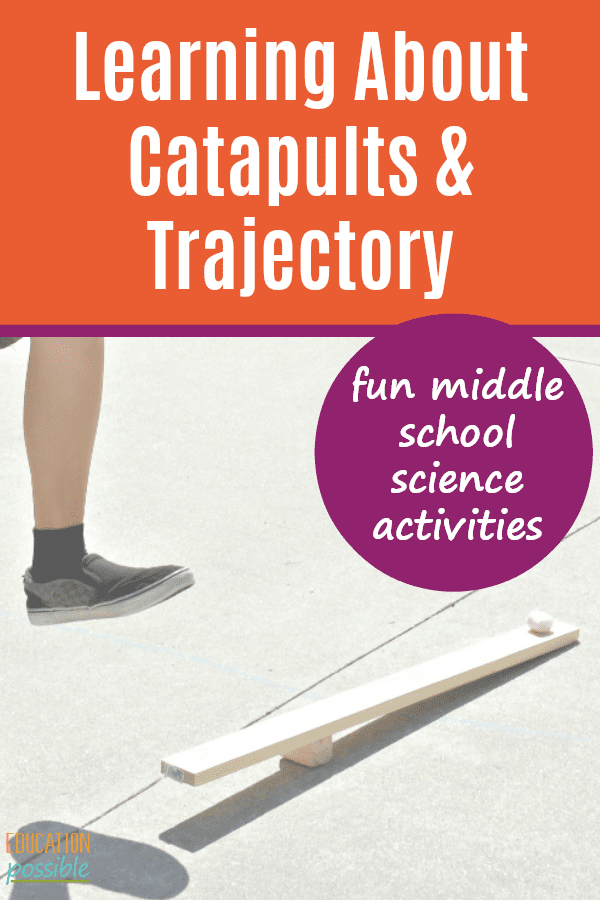Use These Fun Activities to Learn About Catapults and Trajectory
Our science studies have recently taken us into the field of physics, specifically catapult trajectory.
So how do you study trajectory? By hurling things into the air!
To do that, we needed to build a catapult and put some of our questions to the test through some science activities for middle school.

This post contains affiliate links.
Trajectory is the path a free-flying object (a projectile) follows through the air. A projectile has two forces working on it. The inertia that launches it into the air and the gravity that brings it back down to earth.
Simple Catapults
A catapult is something you can use to launch something a far distance away, using the release of accumulated tension instead of explosives. I wanted to make simple catapults for the kids in our science co-op to use during our trajectory experiment.
My husband took the wood we used for our lever experiments and cut it down to make catapults. He made a variety of sizes so the kids could see if the size of the catapult made a difference to the trajectory.
Some had a longer arm and others had a slightly thicker base.
Catapult Trajectory Science Experiment
After teaching the kids about trajectory and outlining the experiment we were going to do, I asked each of the kids what they thought was going to happen, their hypothesis.
They all seemed to think that the items they were launching were going to soar through the air and land many feet away.
We headed outside to test this hypothesis.
First, everyone chose one of the catapults and a small stuffed animal to launch. The kids put their animal on the end furthest away from the base and stepped down on the other one. The animals went straight up into the air and landed close to the catapult. None of them traveled too far.

They decided to try again, this time increasing the force by stepping harder. Some of animals moved further, especially for the bigger kids. One of the kids stepped so hard, he broke his catapult in two!

On the final attempt, the kids jumped or stepped onto the end of the catapult as hard as they could. This did send the animals the highest they had been, but it was still less than what everyone was expecting.

What the Kids Learned About Catapults and Trajectory
It was obvious through the three attempts that trajectory is only changed by two things; the speed at which you launch the projectile and its angle during launch. When you increase or decrease the speed or angle during takeoff, the trajectory of the projectile will change.
Even though we had varied the catapult sizes slightly, there wasn’t really enough difference between them to launch the objects we had chosen off into higher trajectories.
By increasing the speed at which they were launched (by stepping on the board harder) some kids were able to lengthen the distance they flew. If we had also increased the angle of the wood, we probably would have seen a bigger difference in the path.
Since we couldn’t change the angle of the catapult, we decided to try it with a lighter object, a marshmallow. The kids followed the same steps as before but had much better results. The decreased weight of the projectile was a much better match for the catapults we had.

Your tween can learn more about catapult physics including the trebuchet, mangonel, and more. But don’t stop at science. This is a great activity to add to your lesson plans when you’re studying Medieval history.
There’s an easy tabletop version included in this hands-on history kit.
This experiment was a fun way to learn about trajectory. We just love bringing science to life in our homeschool.

MORE FUN SCIENCE EXPERIMENTS FOR MIDDLE SCHOOL
- 25+ Fun Science Experiments for Middle School Myth Busters
- Fun Activities to Learn About Friction
- Learning Science with Disney Imagineering Videos
- Science Activities to Learn About Levers
- Fun Summer Science Experiments for Middle School
HELPFUL MIDDLE SCHOOL SCIENCE TOOLS
Do your kids love to study trajectory by sending things into the air with a catapult?



Hi! Just popping in to say hello – the SITS Tribe Building Challenge started today and we’re ‘tribe mates’. Looking forward to getting to know you.
Hi Tonia. Thanks so much for stopping by. I’m looking forward to getting to know you through our fun tribe challenges!
Hi Megan, I really enjoyed this post. We did something like this a few weeks ago. I think we’ll try again, but this time we’ll change up the objects like you guys did. Looking forward to connecting more via our tribe.
Hi Darcel! I’m also looking forward to getting to know you. I’m glad you liked the post and I hope you have the success that we did by mixing up the projectiles. This was definitely a kid favorite!
I am loving this experiment and how much you learned from the first unexpected results. Thanks for sharing with Afterschool!
Thank you Natalie. I was very surprised by our results. Luckily we had done another type of catapult as well that used small, light objects, so I had some substitutes for the stuffed animals. The kids really wanted to see their objects fly!!
I love this idea! I’ve pinned it to my science board so I can remember it later. My daughter will love this!
Stopping by to say to hi to a fellow Tribe member!
I’m glad you stopped by Tara! It was definitely one of our favorite experiments. The kids really loved launching things into the air! Thank you for pinning.
Love this post! I featured it at the After School Linky today.
oh this looks fun! Thanks for linking up at the Saturday Science Blog Hop & Link Up! I hope you stop by and link up again this week!
Thank you Samantha! We love doing fun experiments for science. This was one of our favorites! I’m glad we found your blog hop 🙂 I’m sure we’ll link up again soon.